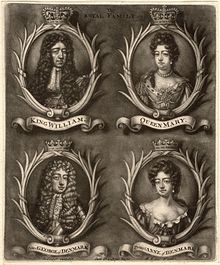Bernard Lens II

Bernard Lens II (1659–1725) was an English engraver, pioneer of mezzotint technique, and publisher.
Bernard Lens II was the son of Bernard Lens I, "an obscure painter"[1] of Dutch origin. Bernard Lens I practiced enamel technique and also authored religious treatises.[2]
The art of Bernard Lens II, largely confined to developing mezzotint technique is an example of a general trend of hist age, when "issues of tonality, if not colour, were developing away from the etching's dependence on line".[2] According to Malcolm Charles Salaman, "most attractive" of his portraits was that of Lady Mary Tudor.[1] Salaman noted Lens for his "practically unique"[3] insights into capabilitites of mezzotint in rendering artificial light, evidenced by his series of Fireworks.[1][3] These prints, commemorating the victories of the Williamite War in Ireland, were "the essential component of representational amplification in politics" of the period.[4]
Bernard Lens II was the father of better known miniaturist Bernard Lens III. Father and son collaborated on joint projects, for example during the 1710 tour of Native American chiefs to England. On the last day of their stay in London Bernard Lens III produced miniature portraits of the "Four Kings";[5] Bernard Lens II copied these portraits in mezzotint, including a widely copied leaflet presenting all four portraits.[6]
References and notes
Sources
- Malcolm Charles Salaman (2008) [1906]. The Old Engravers of England in Their Relation to Contemporary Life and Art 1540 to 1800. Kessinger (reprint). ISBN 1417951192, ISBN 978-1-4179-5119-2.
- Malcolm Charles Salaman (2009) [1917]. The Graphic Arts of Great Britain. BiblioBazaar, LLC (reprint). 1110765940, ISBN 978-1-110-76594-2.
- Alden T. Vaughan (2006). Transatlantic encounters: American Indians in Britain, 1500-1776. Cambridge University Press. ISBN 0521865948, ISBN 978-0-521-86594-4.
- David Worrall (2006). Theatric revolution: drama, censorship and Romantic period subcultures 1773-1832. Oxford University Press. ISBN 0199276757, ISBN 978-0-19-927675-2.
